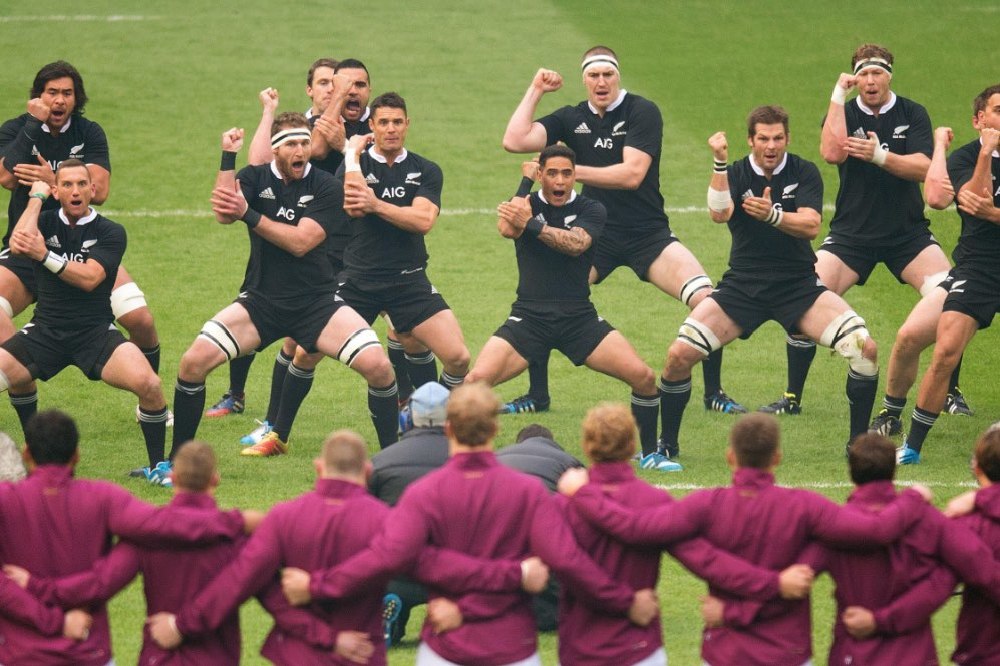In sporting news this week, we saw that a legendary haka performed by the New Zealand rugby union team the All Blacks at the 2011 Rugby World Cup, prior to their game against France, has now reached an impressive 67 million views - and is no doubt the most viewed video in the history of the rugby game.

The All Blacks perform the haka in England v New Zealand QBE International 2013 / Image credit: Mark Pain/Alamy Stock Photo
Led by half-back Piri Weepu, the All Blacks chanted, stomped their feet, slapped their arms and stuck out their tongues at their opponents in a ceremonial dance from Māori culture. It’s not unusual for a New Zealand sports team to perform a haka before a game, but this video fascinated a world of people previously uneducated about this extremely important tradition.
There are several things you ought to know about this tradition:
1. It’s an ancient custom, but not a lost one - Haka haven’t just been unveiled for sporting purposes. It’s not unusual for haka groups - known as kapa hakas - to form in schools, while a biennial competition called Te Matatini is well known amongst New Zealanders. There are still Māori tribes that use haka in their ceremonies.
2. It’s not a war dance - “Haka” is a generic term for a number of Māori ceremonial dances. They’re usually performed as a celebration of life, and are meant as a way to express strong emotions. Some haka, such as the ngeri, would be performed to motivate warriors going to battle, while others like the manawa wera haka were generally performed at funerals. The peruperu, on the other hand, is indeed seen as a war haka.
3. They don’t have to be choreographed - As much as they’re considered a “dance” many haka forms don’t involve synchronicity. They are just as powerful when performed with spontaneity and variation among the dancers.
The choreographed haka that the All Blacks are famous for derives from the "Ka Mate", first led by Te Rauparaha of the Ngāti Toa tribe between the late 1700s and early 1800s. It’s an important ceremonial haka and its use by the All Blacks is sometimes seen as a form of cultural appropriation - their own version of the dance can be seen as rather a perversion of the original in some Māori schools of thought, but in 2009 the Ngāti Toa tribe reached an agreement with the New Zealand Government and the Rugby Union regarding its use.
So why has this video accrued so many views?
Humans are attracted to anything that shows raw, primal emotion. We’re not instinctual animals anymore. The majority of us don’t need to hunt our food or scare away rivals from our wives and houses. Our safety and security has moved us away from our deeper instincts.
But there are moments in life when our raw feelings are thrust into view; making love, giving birth, winning or losing at sport, hostile confrontation and grief are just a few of those things. The haka combines that tribal aggression a person or group might feel defending their families or their land with a determination to win - at least when it comes to rugby. It makes us feel uncomfortable, emotional and riled up, accessing a deep consciousness from our roots.
But the haka isn’t just seen as a show of violence and power - it’s an expression of primal energy. They are performed at funerals and weddings alike and with each occasion, while the basic movements and sounds may stay the same or similar, the energy is different. Funereal haka express a powerful display of mourning and respect for a fallen comrade. Celebratory haka express joyful exuberance.
MORE: Greg Bateman interview: Professional rugby player discusses mental health in sport [EXCLUSIVE]
Sport is a deeply primitive institution that exhibits a feverish excitement from the players and the viewers, often disproportionately. Throwing in something that reminds us of our primitive, animalistic roots at the same time makes it all the more intriguing. No wonder we can’t tear our eyes away!
Tagged in New Zealand Dance

